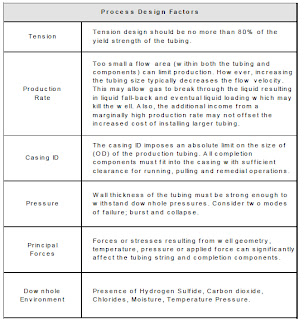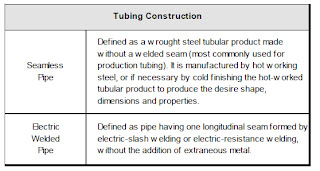Drilling
Drilling and associated operations, (e.g., cementing), performed in the pay
zone must be completed with extra vigilance. It is becoming increasingly
accepted that the prevention of formation damage is easier and much more
cost effective, than the cure. Fluids used to drill, cement or service the pay
zone should be closely scrutinized and selected to minimize the likelihood of
formation damage.
Evaluation
Similarly, the acquisition of accurate data relating to the pay zone is important.
The basis of several major decisions concerning the technical feasibility and
economic viability of possible completion systems will rest on the data obtained
at this time.
Pre-Completion
A precompletion stimulation treatment is frequently conducted. This is often
part of the evaluation process in a test-treat-test program in which the response
of the reservoir formation to a stimulation treatment can be assessed..
Completion Assembly
and Installation
With all design data gathered and verified, the completion component selection,
assembly and installation process commences. This phase carries importance
since the overall efficiency of the completion system depends on proper
selection and installation of components.
A “visionary” approach is necessary since the influence of all factors must be
considered at this stage, i.e., factors resulting from previous operations or
events, plus an allowance, or contingency, for factors which are likely or liable
to affect the completion system performance in the future.
The correct assembly and installation of components in the wellbore is as
critical as the selection process by which they are chosen. This is typically a
time at which many people and resources are brought together. The demands
brought by high and mounting, daily charges imposes a sense of urgency
which requires the operation to be completed without delay. To ensure the
operation proceeds as planned, it is essential that detailed procedures are
prepared for each stage of the completion assembly and installation. The
complexity and detail of the procedure is largely dependent on the complexity
of the completion.
Primary Completion
Components
Primary completion components
are considered essential for the completion to
function safely as designed. Such components include the safety valves, gas
lift equipment, tubing flow control tools and packers. In special applications,
(e.g., artificial lift), the components necessary to enable the completion system
to function as designed will normally be considered primary components.
Completion System
Several types of devices, with varying degrees of importance, can be installed
to permit greater flexibility of the completion. While this is generally viewed as
beneficial, a complex completion will often be more vulnerable to problems or
failure, (e.g., due to leakage).
The desire for flexibility in a completion system stems from the changing
conditions over the lifetime of a well, field or reservoir. For example, as the
reservoir pressure depletes, gas injection via a side pocket mandrel may be
necessary to maintain optimized production levels. The selection of completion
components and fluids should reflect a balance between flexibility and simplicity.
Completion Assembly
and Installation Factors
Completion Fluids
A significant fluid sales and service industry has evolved around the provision
of completion fluids. Completion fluids often require special mixing and hauling
procedures, since (a) the level of quality control exercised on density and
cleanliness is high and (b) completion fluids are often formulated with
dangerous brines and inhibitors.
Initiating Flow
The process of initiating flow and establishing communication between the
reservoir and the wellbore is closely associated with perforating operations. If
the well is to be perforated overbalanced, (higher pressure in the wellbore than
in the formation) then the flow initiation and clean up program may be dealt
with in separate procedures. However, if the well is perforated in an
underbalanced condition, (lower pressure in the wellbore than in the formation)
the flow initiation and clean up procedures must commence immediately upon
perforation.Production Initiation
Underbalanced
Perforating
Perforating when the reservoir pressure is substantially higher than the wellbore
pressure is referred to as under-balanced perforating. While the reservoir/
wellbore pressure differential may be sufficient to provide an underbalance at
time of perforation, the reservoir pressure may be insufficient to cause the well
to flow after the pressure has equalized.
Adequate reservoir pressure must exist to displace the fluids from within the
production tubing if the well is to flow unaided. In the event the reservoir
pressure is insufficient to achieve this, measures must be taken to lighten the
fluid column typically by gas lifting or circulating a less dense fluid.
The flow rates and pressures used to exercise control during the clean up
period are intended to maximize the return of drilling or completion fluids and
debris. This controlled backflush of perforating debris or filtrate also enables
surface production facilities to reach stable conditions gradually.
Wellbore Clean Up
Wellbore cleanup is normally not required with new completions. However, in
wells which are to be re-perforated or in which a new pay zone is to be opened,
a well bore clean up treatment may be appropriate. There is a range of perforation
treatments associated with new or recompletion operations.
Overbalanced
Perforating
Perforating when the wellbore pressure is higher than the reservoir pressure is
referred to as Overbalanced Perforating. This is normally used as a method of
well control during perforating. The problem with this method is it introduces
wellbore fluid into the formation causing formation damage.
It is sometimes desirable to place acid across the interval to be perforated when
overbalanced perforating. The resulting inflow of acid results is a matrix type
acid treatment occurring.
Extreme Overbalance
Perforating
In this type of perforating operation the wellbore is pressured up to very high
pressures with gas (usually nitrogen). When the perforating guns are detonated
the inflow of high pressure gas into the formation results in a mini-frac, opening
up the formation to increase inflow.
Stimulation Treatments
Acid Washing
of Perforations
Perforation acid washing is an attempt to ensure that as many perforations as
possible are contributing to the flow from the reservoir. Rock compaction, mud
and cement filtrate and perforation debris have been identified as types of
damage which will limit the flow capacity of a perforation and therefore,
completion efficiency.
If the objective of the treatment is to remove damage in or around the
perforation, simply soaking acid across the interval is unlikely to be adequate.
The treatment fluid must penetrate and flow through the perforation to be
effective. In which case all the precautions associated with a matrix treatment
must be exercised to avoid causing further damage by inappropriate fluid
selection.
Hydraulic Fracturing
Hydraulic fracturing treatments provide a high conductivity channel through
any damaged area and extending into the reservoir. The natural fractures
within the formation material are opened up using hydraulic fluid pressure.
Commonly a proppont such as sand is introduced to ‘prop’ the fracture open
after the pressure is removed, but still will allow flow of reservoir fluids and
gases. Hydraulic fracturing treatments require a detailed design process which
is usually performed by the service supplier.
Well Service
and Maintenance
Requirements
The term “well servicing” is used (and misused) to describe a wide range of
activities including:
- Routine monitoring
- Wellhead and flowline servicing
- Minor workovers (through-tubing)
- Major workovers (tubing pulled)
- Emergency containment or response
Well service and maintenance preferences and requirements must be considered
during the completion design process. With more complex completion systems,
the availability and response of service and support systems must also be
considered.
Well bore geometry and completion dimensions determine the limitations of
conventional slick line, wireline, coiled tubing or snubbing services in any
application.
Logistic and
Location Constraints
Restraint imposed by logistic or location driven criteria often compromise the
basic cost effective requirement of a completion system. Special safety and
contingency precautions or facilities are associated with certain locations,
(e.g., offshore and subsea).
Logistic and
Location Criteria
Client Requirements
The completion configuration and design must ultimately meet all requirements
of the client. In many cases, these requirements may not be directly related to
the reservoir, well or location (technical factors). An awareness of these factors
and their interaction with other completion design factors can help save time
and effort in an expensive design process.
The following factors are common criteria which must be considered:
- Existing stock or contractual obligation
- Compatibility with existing downhole or wellhead components
- Client familiarity and acceptance
- Reliability and consequences of failure
Regulatory Requirements
There are several regulatory and safety requirements applicable to well
completion operations. These must satisfied during both the design and
execution phases of the completion process.
- Provision for well-pressure and fluid barriers
- Safety and operational standards
- Specifications, guidelines and recommendations
- Disposal requirements
- Emergency and contingency provision
Revenue and Costs
When completing an economic viability study, or comparison, the costs
associated with each of the following categories must be investigated.
- Production revenue
- Capital cost (including completion component and installation cost)
- Operating cost (including utilities and routine maintenance or
servicing cost, also workover, replacement or removal cost)
Installation costs are significant if special completion requirements impact the
overall drilling or completion time. The actual cost of completion components
is often relatively insignificant when viewed alongside the value of incremental
production from improved potential or increased uptime.
Economic Factors
A rudimentary understanding of the economic factors is beneficial.
- Market forces (including seasonal fluctuations and swing
production)
- Taxation (including tax liability or tax breaks)
- Investment availability
Company Objectives
A measure of success can only be made if there exists clearly stated objectives.
Such objectives may macroscopic, but nonetheless will influence the specific
objectives as applied to an individual well or completion. In addition, the wider
company objectives may allow clarification of other factors, (e.g., where two or
more options offer similar or equal benefit and no clear selection can be made
on a technical basis).
- Desired payback period
- Cash flow
- Recoverable reserves




























